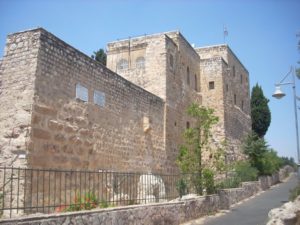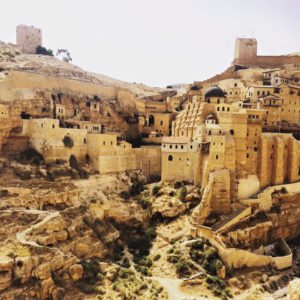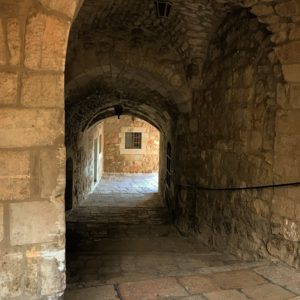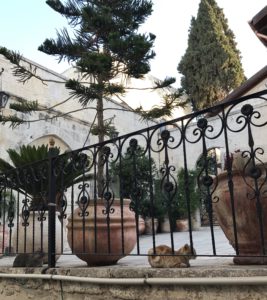
Blog-post author Professor Anthony Bale, Birkbeck, University of London
(@RealMandeville)
The Greek Orthodox Patriarchate in the Old City of Jerusalem is one of the most important resources for understanding the religious history of the Holy Land: in the Patriarchal Library are gathered the ancient manuscript treasures of the Church of the Holy Sepulchre and several other monasteries in the region.
-

The Monastery of the Holy Cross, Jerusalem. Photo: Anthony Bale 
The Monastery of Mar Saba, near Bethlehem. Photo: Anthony Bale The Library’s main holdings comprise the Greek manuscripts previously held at Mar Saba near Bethlehem and the unique Greek and Georgian manuscript holdings of the Monastery of the Holy Cross (a Georgian foundation which is now a Greek house) in west Jerusalem.
In my work tracing the manuscripts held at the now-vanished medieval Franciscan monastery at Mount Zion, I had wondered if any pilgrims’ books might have found their way to a Greek monastery in the region. I was thus intrigued to find that amongst the Patriarchal Library’s holdings – which are overwhelmingly Greek and Georgian in origin – there is one Latin manuscript: MS Taphou 27.
Thanks to the assistance of Archbishop Aristarchos of Constantina, I was recently able to examine MS Taphou 27, to see if the book could be more securely associated with its medieval owners. What follows is very much a preliminary account of the manuscript, a starting-point for plotting the biography of a manuscript that seems to be ‘out of place’.

Inside the Greek Orthodox Patriarchate, Jerusalem. Photo: Anthony Bale Taphou 27 is a copy of Eutropius, a Classical chronicle dealing with Roman history. It was a very widely-read work, in both humanist circles and as a school text-book. Taphou 27 dates from the later fifteenth century, and includes some exceptionally beautiful illustrations and fine decorated lettering. The manuscript was almost certainly made in Italy, perhaps in Milan or Naples. It has a post-medieval binding, apparently British of c. 1800, and some of the book’s folios have been clipped.
There are a few clues in the book about its history and its journey from Italy to Jerusalem and the Greek Patriarchate. First, on the book’s first folio, are two Greek inscriptions, in different hands. The first, hard to decipher, suggests that the book was at Constantinople, at the Metochion of the Holy Sepulchre, by the year 1677. The second says that the book comes from “the belongings of Panayotis…which are useful to him” – it’s not clear exactly who or what this refers to. Over the coming months I hope to explore the possible meanings of these inscriptions with members of the Pilgrim Libraries project who are more familiar with Greek materials.
As Christopher Wright has shown, the manuscript was part of a large number of ancient books that were taken from the Ottoman empire to England, c. 1801, by Joseph Dacre Carlyle, Professor of Arabic at Cambridge, via the British embassy in Constantinople. Carlyle certainly took at least six books from Mar Saba, as a surviving receipt shows (now The National Archives, FO 78/81, f. 56r), and a number of manuscripts from the Metochion, lent by the Patriarch of Jerusalem Anthimos, who at that time resided in Constantinople. The manuscript passed to Carlyle’s sister Maria in 1804, and she retained it as a memento, having given the bulk of her brother’s collection to Lambeth Palace Library. The manuscript was returned by Maria Carlyle to the Greek Patriarchate around 1813, via the Patriarch Polycarpus. A Greek note on the front of MS Taphou 27 confirms the return of the book from England.
An important though previously overlooked aspect of MS Taphou 27 is that it contains the name of its scribe. On f. 138v, the final folio of the text, the scribe has written in his beautiful humanistic hand
I A C O B U S Laurentianus scripsit.
This Iacobus Laurentianus was the scribe of the whole volume. Laurentianus is by no means an unknown scribe: on the contrary, he was evidently a prestigious and highly-productive scribe in late fifteenth-century Italy, his work including commissions for the Aragonese court in Naples and the Sforza family in Milan. My preliminary research shows that a group of surviving Laurentianus manuscripts can be traced, now in collections around the world (given in a working hand-list below).
MS Taphou 27 can therefore be added to the known works written by Jacobus Laurentianus. It is not clear from the book however if it was written to commission – in my inspection of the book, I did not see any heraldic devices or similar evidence that would point to a medieval patron. As W. S. Monroe has shown, Laurentianus’ manuscripts were sometimes copied from printed texts, and MS Taphou 27 was likely copied from the printed edition of Eutropius (Rome, 1471); Laurentianus copied another manuscript of this text, now in the Escorial in Madrid.
This still doesn’t get us any closer to establishing how the book got from Italy to the Middle East, although the Greek inscriptions suggest that it was there by the mid-seventeenth century. The library of the Dukes of Aragon, based at Naples, shows that it held three books by Jacobus Laurentianus, including the copy of Eutropius, now in the Escorial, dedicated to Ferdinand/Ferrando of Aragon and, as Tammaro de Marinis shows, written at some point between 1471 and 1480. The Jerusalem manuscript is therefore almost certainly closely connected to this prestigious commission, although as I have not yet inspected the Escorial manuscript I cannot be sure of the relationship between the two. The Aragonese library at Naples was broken up in the later fifteenth century.
I am not at present in a position to make any firmer or larger conclusions about the book’s history but it is clear that Taphou 27 presents an intriguing piece of evidence in our attempts to understand the movement of books in the late medieval and early modern Eastern Mediterranean.
A provisional hand-list of manuscripts written by the scribe Jacobus Laurentianus
- Florence, Biblioteca Marucelliana MS ACB.IX.83
- Florence, Biblioteca Riccardiana MS 1569.s.15 (“Iacobus de s. Laurentio”)
- Jerusalem, Greek Orthodox Patriarchal Library MS Taphou 27
- Madrid, Escorial MS H.II.2; produced for the Aragonese court at Naples
- Naples, Biblioteca Nazionale di Napoli MS XI.AA.51
- Naples, Biblioteca Nazionale di Napoli MS XIII.C.76
- Paris, Bibliotheque National de France MS italien 1712, Vita de santi padri (1465); this manuscript seems to have been owned by Ippolita Sforza.
- Providence, Brown University, John Hay Library MS Latin Codex 9
- Rome, Biblioteca Casanatense, MS 112 (Laurentianus was the scribe of some sections)
- ?Venice, Biblioteca Marciana MS Lat. vi.245, Pliny the Elder
- Current whereabouts unknown: Diodorus Siculus (“Iacobus Laurentianus scripsit”), mentioned by Cherchi and de Robertis.
References and further reading
Paolo Cherchi and Teresa de Robertis, “Un inventario della biblioteca aragonese,” Italia medioevale e umanistica 33 (1990): 109-307
Lampadaridi, Anna, “Jerusalem, Library of the Patriarchate_1808-1827”, in Jerusalem, Patriarchy Library, Panaghiou Taphou 27 , Paris, IRHT, 2016 (Ædilis, Sites of scientific programs, 4) [Online] http: //www.libraria .fr / en / RIMG / jérusalem-librairie-du-patriarcat1808-1827
de Marinis, Tammaro, La biblioteca napoletana dei re d’Aragona (Milan, Hoepli, 1947-52) 4 vols.
Monroe, William S., “The Scribe, Iacobus Laurentianus, and the Copying of Printed Books in the Fifteenth Century”, paper presented at the Medieval Academy of America meeting, Vancouver 2008
Schadee, Hester. “The First Vernacular Caesar: Pier Candido Decembrio’s Translation for Inigo d’Avalos with Editions and Translations of Both Prologues.” Viator 46.1 (2015): 277-304.
Wright, Christopher, ‘Provenance and sub-collections’, in Christopher Wright, Maria Argyrou and Charalambos Dendrinos, A Descriptive Catalogue of the Greek Manuscript Collection of Lambeth Palace Library [Online] https://www.royalholloway.ac.uk/Hellenic-Institute/Research/LPL/Greek-MSS/Catalogue.pdf
I would like to thank the following for the help in drafting this blogpost: William S. Monroe, Marina Tompouri, Kostya Tsolakis, Nickiphoros Tsougarakis, and Archbishop Aristarchos of Constantina, Elder Secretary-General of the Greek Patriarchate, Jerusalem.

Inside the Greek Orthodox Patriarchate, Jerusalem. Photo: Anthony Bale


